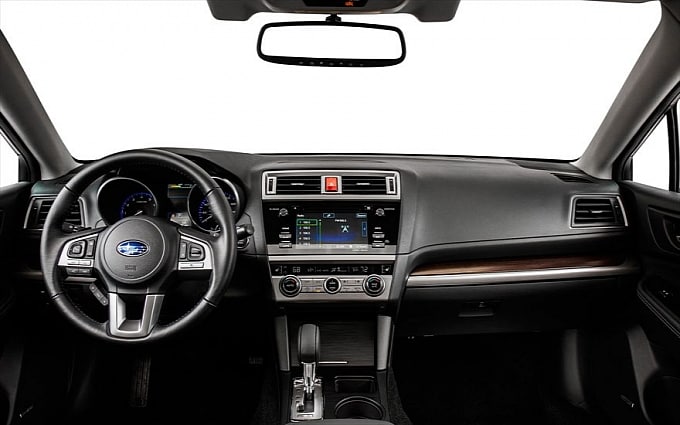First Drive: 2015 Hyundai Sonata
#1
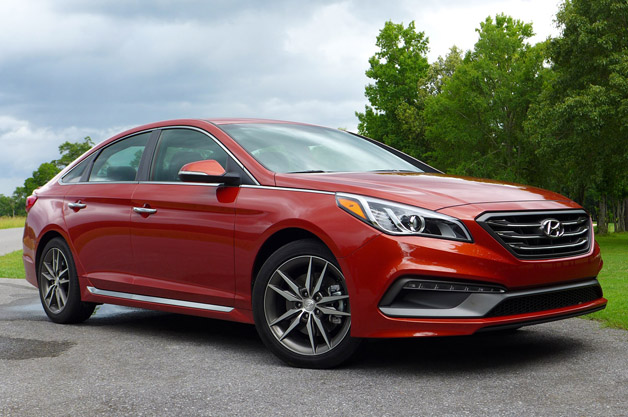
Gallery:
http://www.autoblog.com/photos/2015-...photo-2741109/
Completely redesigning a vehicle competing in a fiercely contested segment requires delicately balancing styling, performance, safety, efficiency, innovation, passenger comfort and pricing, while simultaneously not alienating model loyalists. In other words, it's no simple task.
Automakers generally follow one of two paths. Some take a conservative approach and choose to raise each bar marginally, in an effort to appease all and estrange none. Others strategically take risks and focus on specific attributes in an attempt to shift perception about their vehicle.
With its all-new 2015 Sonata, Hyundai has taken the second approach when overhauling one of its best-selling vehicles. The Korean automaker has executed an impressive number of targeted improvements, yet it's also softened some of its predecessor's qualities in an attempt to demonstrate greater refinement and position its midsize sedan upscale. Whereas the outgoing car successfully aimed to establish itself as a credible contender in the midsize segment, the new model is gunning for customers that might otherwise be seeking entry-level models from luxury automakers.

Montgomery, the capital of Alabama, is an unusual locale to launch a completely redesigned vehicle – unless you happen to be Hyundai. The automaker rolled its first new car out of Montgomery's Hyundai Motor Manufacturing Alabama (HMMA) in the southern state in 2005, with its production output hitting 398,000 units in 2013. This year, the plant welcomes assembly of the 2015 Sonata alongside the Elantra, a hot-selling compact sedan that commands 32 percent of its sales. Coming in second place, with 27 percent of the automaker's sales, is the four-door, midsize Sonata sedan. Launched in 1998, the all-new 2015 model is a seventh-generation (Hyundai calls it the LF platform) iteration that made its North American debut at this year's New York Auto Show.
Rather than toss us the keys in a hotel parking lot, as is common practice, our host gave us a guided tour of HMMA while arranging to have our test cars waiting at the end of the active line. Eager journalists jumped behind the wheel as the sedans crept along a moving conveyor and then drove them out of the factory door for the obligatory photo opportunity.
Following my peers, I vaulted into the sportiest and most vibrant of the six new models (SE, Sport, Limited, Sport 2.0T, Sport 2.0T w/Ultimate, and Eco), a Sport 2.0T sedan painted Urban Sunset with black leather offset with orange piping (the color doesn't translate well in pictures – think metallic rust if you want to paint a mental picture). While the base SE model is actually cheaper than last year's model at $21,960 (including $810 destination), my test car arrives in showrooms with a base price of $29,385 (including destination). It was wearing no options.
Hyundai is very proud of its new Fluidic Sculpture 2.0 styling language, which is said to reek of "modern premium," but I'm still a bigger fan of last year's exterior that was at once both more aggressive and youthful. Nevertheless, this fresh, conservative look is decidedly more upmarket and it complements the design of the new Genesis sedan, its recently launched big brother. The new sculpture is also sleeker to the wind, with a drag coefficient of just 0.27 thanks to those carefully crafted panels and a near-full underbody tray to manage airflow. (It's important to note the test car shown here is a Sport model, which features a more aggressive front grille and bumper, side chrome molding and side rocker extensions in addition to a unique rear fascia and quad exhaust outlets.)
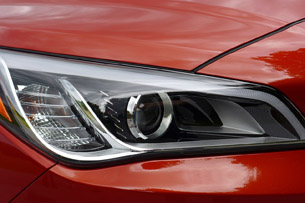
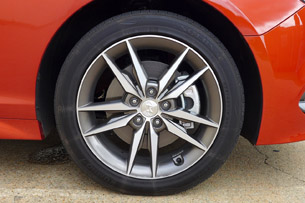
Despite my need to warm to the exterior, I have far fewer complaints with the interior, which has moved upscale, mimicking many of the design cues of the premium Genesis sedan. Dropping my six-foot, two-inch frame into the supportive sport seats in the 2.0T (which are about twice as comfortable as the flatter seats of non-sport models) reveals a wider center console that gives the occupants a new sense of personal space. There is less dashboard "wrap-around," which adds an impression of openness. By the tape, the new Sonata boasts 106.1 cubic feet of passenger volume and a total interior volume of 122.4 cubic feet, which allows the midsize sedan to be classified as a large car by the EPA.
Materials, as well as fit and finish, are impressive for a vehicle in this price range – again, trickle-down from the Genesis – but also required to maintain competitiveness. My Sport model was configured with a meaty flat-bottom steering wheel and textured aluminum trim, which are pleasing to the touch and tasteful (time within a Limited model revealed lamentably fake wood trim that wouldn't fool a kindergartener). In both cases, well-sorted ergonomics meant I wasted no time looking for switchgear.
The Sonata's standard equipment level is generous, with all models fitted with full power accessories, remote keyless entry, premium cloth upholstery and 60/40 split-fold rear seats. Optional equipment, mostly bundled into packages, includes leather upholstery, a panoramic glass moonroof, heated rear seats, Xenon headlights, radar-based cruise control with full stop capability and Hyundai's hands-free Smart Trunk, a feature launched on the Genesis sedan. There are no hubcaps in the Sonata lineup, as even the base SE model arrives with 16-inch alloy wheels and 205/65R16 tires (the Sport 2.0T model wears the largest wheel/tire package with 18-inch alloys and 235/45R18 tires).
With regards to connectivity, all models come with iPod/USB/AUX inputs, SiriusXM satellite radio and Bluetooth for phones. While the base Sonata lacks a color infotainment display, a five-inch color touchscreen is one model level up with a vibrant eight-inch color display optional. Hyundai is also offering Apple CarPlay integration with certain headunits (late availability) and a 400-watt Infinity premium audio system with next-generation Blue Link telematics.
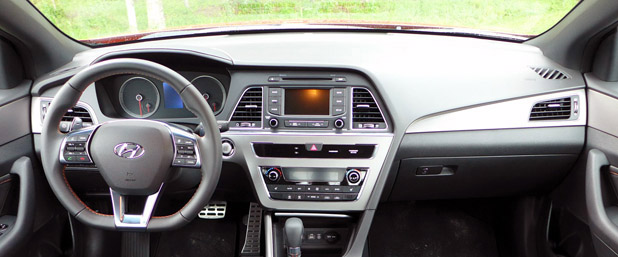
Not leaving safety out of equation, Hyundai set the Insurance Institute for Highway Safety (IIHS) Top Safety Pick+ rating as its target (the Sonata has yet to be officially tested, but the automaker says it's confident it will receive the award). In addition to all of the government-mandated safety gear, the sedan arrives with new standard knee airbags and is offered with optional Lane Departure Warning (LDW), Forward Collision Warning (FCW), Blind Spot Detection (BSD) and Rear Cross-traffic Alert (RCTA).
Hyundai plotted out a circuitous route on the outskirts of Montgomery that led across highways and two-lane country roads. The weather was lousy, as downpours spoiled most of the best photo opportunities, but traffic was light and the asphalt unbelievably smooth (the only bump in the road was a deceased armadillo – no kidding).
Up until a few years ago, the midsize sedan segment was accustomed to four- and six-cylinder engine offerings, but Hyundai forged a new path for the class in 2009 when it introduced the sixth-generation Sonata with nothing but a range of four-cylinder engines. The company's logic was sound – a lower-displacement turbocharged engine can offer identical power and better efficiency, while the smaller packaging requirements of a four-cylinder allow the firewall to be pushed forward, thereby giving more space to the occupants. Hyundai customers have seemed indifferent about the loss of a six-cylinder option, so the automaker hasn't altered its tune. For the 2015 model year, the Sonata will be offered with three, four-cylinder engines in the new platform (the Hybrid will continue to be offered on the previous-generation platform until 2016).
Of the three combustion engines, two are returning to the Sonata after being updated and one is new to the model.
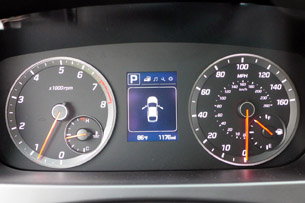
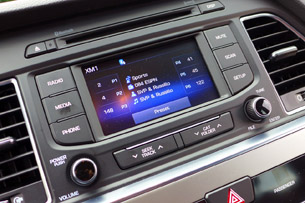
The standard 2.4-liter Theta II GDI four-cylinder engine, which is fitted to the SE, Sport and Limited models, arrives with a new power rating of 185 horsepower and 178 pound-feet of torque (last year, it was rated at 190 horsepower and 179 pound-feet). Upgraded with Electronic Intake Continuously Variable Valve Timing (E-CVVT), the engine trades in five horsepower and a single pound-foot to offer "better responsiveness in lower-RPM situations where customers spend the majority of their time," says the automaker. It has also been tuned for improved cold-weather performance and reduced emissions. The engine is mated to a six-speed automatic transmission sending power to the front wheels. Its preliminary fuel economy ratings are 24 miles per gallon city, 35 highway and 28 combined (the SE model is rated slightly higher, at 25/37/29).
The optional 2.0-liter Theta II turbocharged GDI four-cylinder, which is fitted to the Sport 2.0T models, is also equipped with E-CVVT. It arrives with a new rating of 245 hp and 260 lb-ft (last year, it was rated at 274 hp and 269 lb-ft). The significantly decreased output rating is a result of a new, smaller turbocharger – less mass means it spools quicker and improves driveability. Like the 2.4-liter, it is mated to a six-speed automatic driving the front wheels. Its fuel economy ratings are 23 city, 32 highway, 26 combined.
Fuel mileage numbers are up very slightly across the Sonata range, when comparing the new engine variants with the old. Those seeking the greatest efficiency this side of the hybrid offering, however, have another option for 2015.
The new engine in the model range is a 1.6-liter turbocharged inline-four, which will be standard in the Eco variant, and it's rated at 177 hp and 195 lb-ft of torque. Unlike its siblings, the low-displacement powerplant is bolted to an all-new, seven-speed, dual-clutch automatic transmission. Its preliminary fuel economy ratings are 28 city, 38 highway, and 32 combined.
To better tailor the powertrain to the driver and driving conditions, all Sonata models are equipped with three drive modes (Eco, Normal and Sport) selectable via a pushbutton switch located just aft of the transmission shift lever. In a nutshell, each configuration alters the engine response, transmission shift points and steering wheel weight to suit the mode. By default, the vehicle starts in Normal each time with a dash light alerting the driver to any changes.
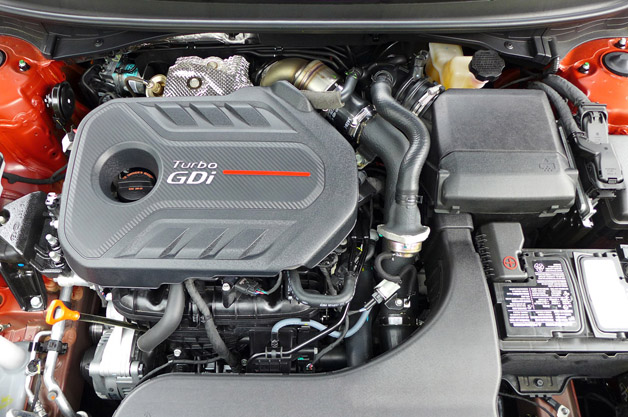
I drove all three models back-to-back in Alabama, and it didn't take long for me to choose my favorite.
he 2.4-liter doesn't feel much different than its predecessor. Good gearing within the automatic transmission allows the naturally aspirated engine to move the 3,252-pound Sonata 2.4 quickly off the line, but it loses some steam once it gets above city speeds. The gearbox is quick to downshift, but it doesn't have the torque to push anyone's skull against their head restraints. Although it doesn't have any issue holding highway speeds on grades, passing maneuvers will require planning and plenty of space, especially with a vehicle loaded with four adults and luggage. The 2.4-liter is a decent standard engine, but it won't get anyone's juices flowing – I'll leave it at that.
Bolting a smaller turbocharger on the 2.0-liter four definitely removes some of its steam, as I recall last year's Sonata 2.0T feeling a bit quicker (I'm betting the 2015 version is slower in the 0-60 sprint). The automatic transmission puts in a herculean effort to keep the engine in its powerband, making passing at speed much easier – but the loss of 29 horses is a blow to performance in the 3,505-pound 2.0T (it's the heaviest trim). The upside is that fuel economy on the city cycle, when the turbocharger is most likely to be utilized, is improved over its predecessor. The big downside is that the sportiest Sonata variant no longer stands a chance against the V6-equipped competition in terms of driver engagement.
My preferred engine is the 1.6-liter with the turbocharger mated to the DCT. It's a brilliant little combo, which easily pulls the Sonata briskly around town, yet it sips fuel on the highway to deliver nearly 40 mpg. The engine is smooth and the shifts from the gearbox are nearly imperceptible, an impressive feat given this is a DCT. In manual mode, activated by pulling the transmission lever towards the driver, aggressive shifting has the needle jumping around the tachometer with lightning-quick reflexes. The 3,270-pound Sonata Eco is by no means the enthusiast model, but it has the eager heart of a sport sedan.
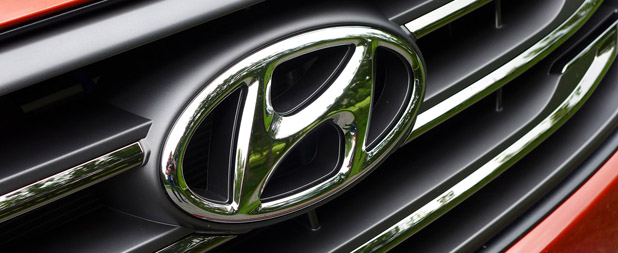
All Sonata models share the same suspension, but there are two different braking and steering systems and wheel/tire options. Hyundai has deservedly accepted some criticism over suspension tuning in past years, but its recently launched Genesis sedan proves that its engineering team is on the right track. To bring the 2015 Sonata up to similar speed, the company is using reinforced side and crossmembers to strengthen the new chassis and improve suspension responsiveness. The chassis doesn't just receive more bracing, the automaker says it employs more high-strength steel to net 41-percent stiffer torsional rigidity and 35-percent improved bending resistance, all of which help let the suspension do its work.
Up front are MacPherson struts, with revised subframe bushings, while the rear relies on a redesigned multilink system that employs dual lower arms to increase lateral stability and improve ride quality. Sport 2.0T models feature more aggressively tuned dampers and springs. New geometry makes the sedan more stable under braking (and contributes to a short stopping distance). Glass-smooth asphalt roads thwarted any thorough test of the new underpinnings, but a few dips and railroad crossings hit at above-average speeds revealed an improved and well-controlled ride that could meet, or exceed, best in class. Transitional stability is good, with the Sonata feeling stable through sweepers. Cornering grip is mostly tire limited.
All Sonata models are fitted with four-wheel disc brakes, but the Turbo and Ultimate models arrive with slightly larger rotors (12.6-inch units up front) for a heavier duty cycle. Pedal feel is reassuring at all speeds, with good modulation. I simulated a panic stop from 60 mph and the Sonata stopped straight and in a surprisingly short distance, with ABS clacking away but without much drama. I wish all midsize sedans stopped as well.
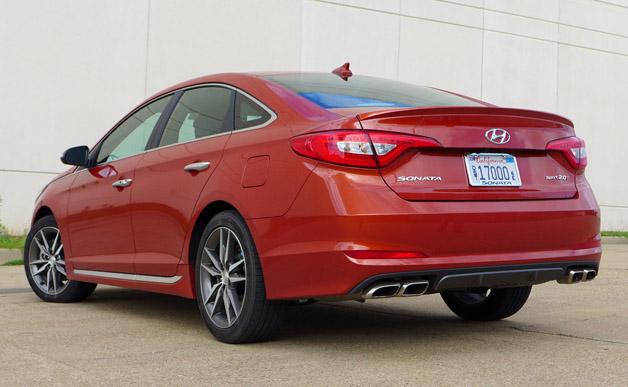
Configuring vehicles with more than one steering rack is common in this segment, as automakers choose equipment to keep costs down. All models, with the exception of the Sport 2.0T, arrive with a column-mounted Motor-Driven Power Steering (MDPS) unit. The Sport 2.0T has a premium rack-mounted MDPS, which is tuned for the enthusiast. Both are engine-RPM-sensing for variable effort. Being completely frank, I was unable to sense a difference between the two racks during a full day's worth of driving (blame a lack of canyon roads to exercise the Sonata). Both were light and a bit numb in the feedback category, but very stable and nicely weighed on the highway.
Without reservation, I like the new Sonata. After a full day inside its cabin, I emerged with a smile, no aching appendages and at a loss to reveal any glaring negative qualities or traits that would prevent me from recommending it to friends or family. But the midsize sedan category is intimidating. The Sonata competes in an extremely competitive segment that includes the Chevrolet Malibu, Chrysler 200, Ford Fusion, Honda Accord, Mazda6, Nissan Altima, Toyota Camry, and Volkswagen Passat, and I can't fail to mention its own cousin, the Kia Optima. A glance at each reveals that none are weak adversaries.
Most would expect Hyundai to counter with an all-new vehicle that follows the path forged by the outgoing model. But rather than introducing a seventh-generation Sonata that pursues its predecessor's objective, which was to establish itself as a credible contender in the midsize sedan segment, Hyundai appears to have much more focused ambitions for its new arrival. By putting economy over performance and using the Genesis sedan as its role model, it has tasked the 2015 Sonata with a more important ambition – going upscale. The resulting four-door sedan is a safe, fuel-efficient, premium offering with an attractive sticker price.
http://www.autoblog.com/2014/06/30/2...-drive-review/
#2
i just yawned and laughed at the same time. talk about a lazy exterior design. i tried to like it. i really did. but i'm already bored with it. but it would be a decent rental. wouldn't mind renting one for my upcoming long distance trip.
#4
Lexus Fanatic
#5
Lexus Fanatic
iTrader: (3)
The quad exhaust is pretty laughable for a 4 cylinder, FWD family sedan.
Also, I am glad to hear that the interior materials are nice quality, but the design of that entire dash board and center stack is absolutely awful and looks horribly cheap. It's a bad rendition on the new Genesis and it doesn't work at all.
Also, I am glad to hear that the interior materials are nice quality, but the design of that entire dash board and center stack is absolutely awful and looks horribly cheap. It's a bad rendition on the new Genesis and it doesn't work at all.
#7
Pole Position
Join Date: Mar 2014
Location: New York
Posts: 262
Likes: 0
Received 0 Likes
on
0 Posts
This is certainly a downgrade from the current Sonata. The styling is all off. Yea, the current styling may be polarizing to some, but it still makes a bold statement which has appealed to many people. The current generation sales numbers improved tremendously over the previous model and it wasn't due to the fact that people all of a sudden decided to give Hyundai a chance. Their buyers liked the sharp 4-door coupe like redesign and hi-tech looking interior. This new Sonata looks completely boring and I can only guess that Hyundai is trying to appeal to more traditional "vanilla" midsize sedan buyers (Camry). This is design back peddling in my opinion and it's not going to work in their favor. They've just alienated their base of buyers from the past 5 years. Bad move 

Trending Topics
#8
Lexus Test Driver
The dash is clearly the biggest demerit. It's sawed off and extremely plain and dated in design. The gauges are also unfinished. The trip computer display is needlessly small and robs the driver of seeing important info above and below it.
Overall, I like the clean exterior lines. But I would say it's a surprising direction for the Sonata, which was known to have standout styling in a sea of boring mid-sized sedans.
Question, how does one manually shift with the automatic shifter? I don't see any +/- in the photos. I hope this is not another car company taking away the public's ability to comfortably shift a lever to better control a car's motion.
Overall, I like the clean exterior lines. But I would say it's a surprising direction for the Sonata, which was known to have standout styling in a sea of boring mid-sized sedans.
Question, how does one manually shift with the automatic shifter? I don't see any +/- in the photos. I hope this is not another car company taking away the public's ability to comfortably shift a lever to better control a car's motion.
#10
The pursuit of F

Also, has anyone noticed how the styling direction has gone towards a 5-door hatchback, especially from that side profile shot? Not convinced I like it say as much as a prior gen Mazda6 hatch or even an A7. On the positive I bet the raked rear glass and shortened deck contributed to the excellent 0.27 drag.
#11
Lexus Fanatic
#12
Lexus Fanatic
iTrader: (3)
^No, it's laughable for a 4 cylinder, front wheel drive family sedan with 245 hp to have quad exhaust. It also looks like it's actually dual exhaust that spits into dual tips on each side. Come on, Hyundai.
If Toyota did this, the internet would be erupting with "rice" comments.
If Toyota did this, the internet would be erupting with "rice" comments.
Last edited by MPLexus301; 07-01-14 at 06:42 AM.
#13
#15
Lexus Fanatic
I've seen dual pipes split into quads more than once, on a number of vehicles, though you're correct that it is somewhat unusual on a non-sport sedan.




